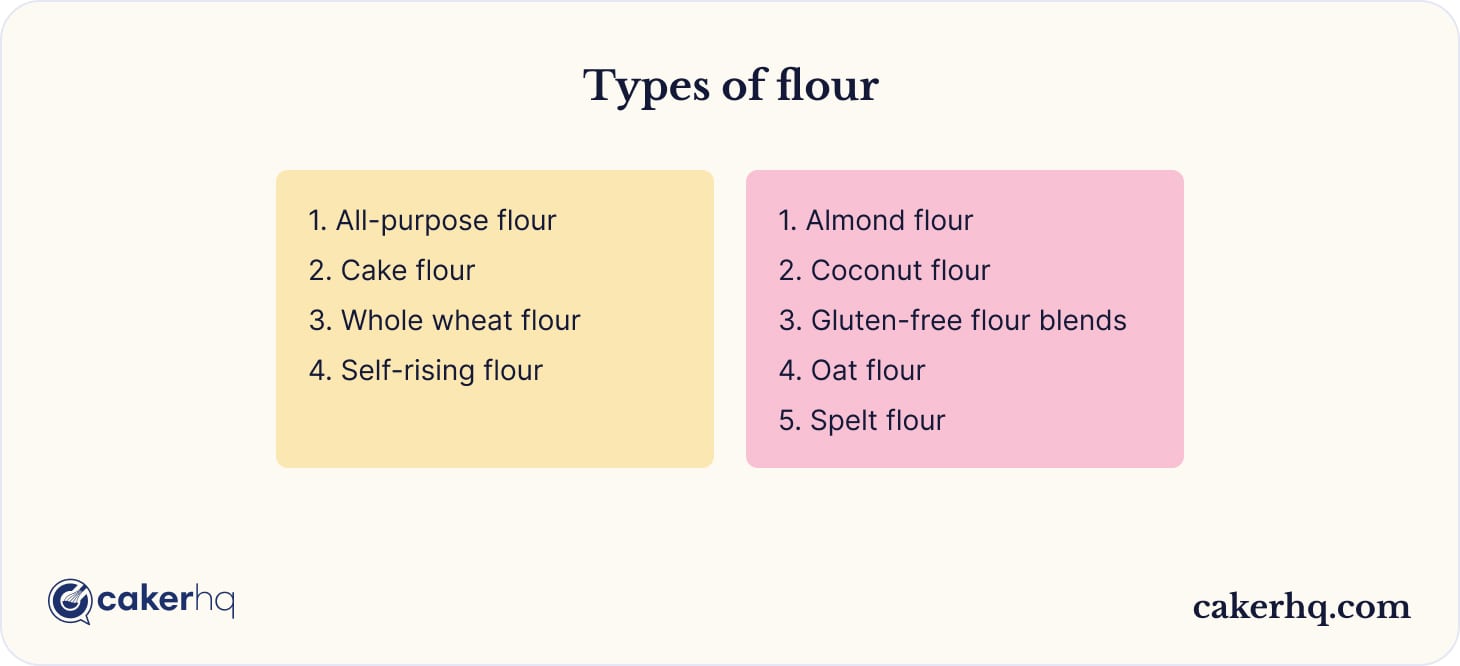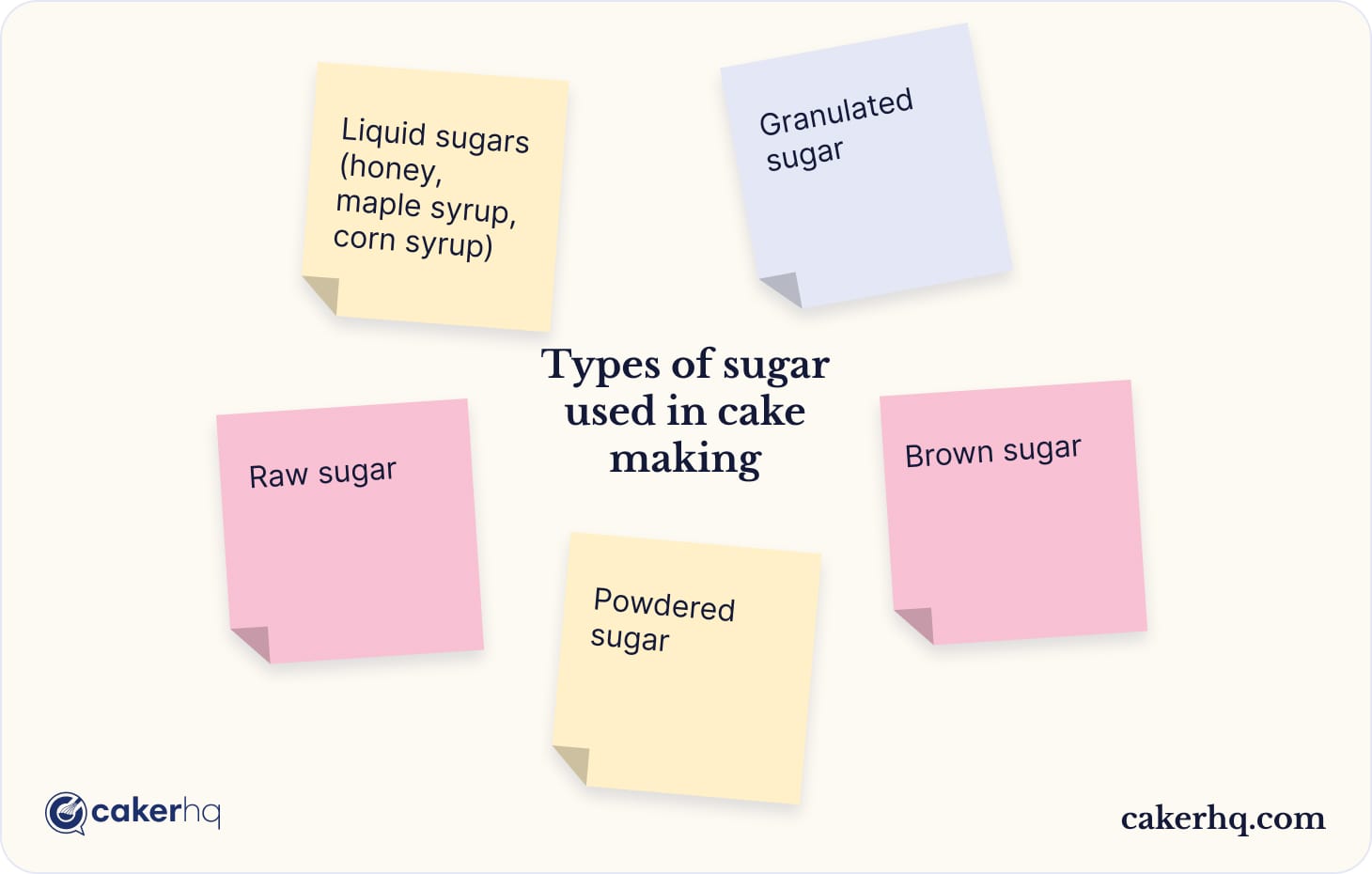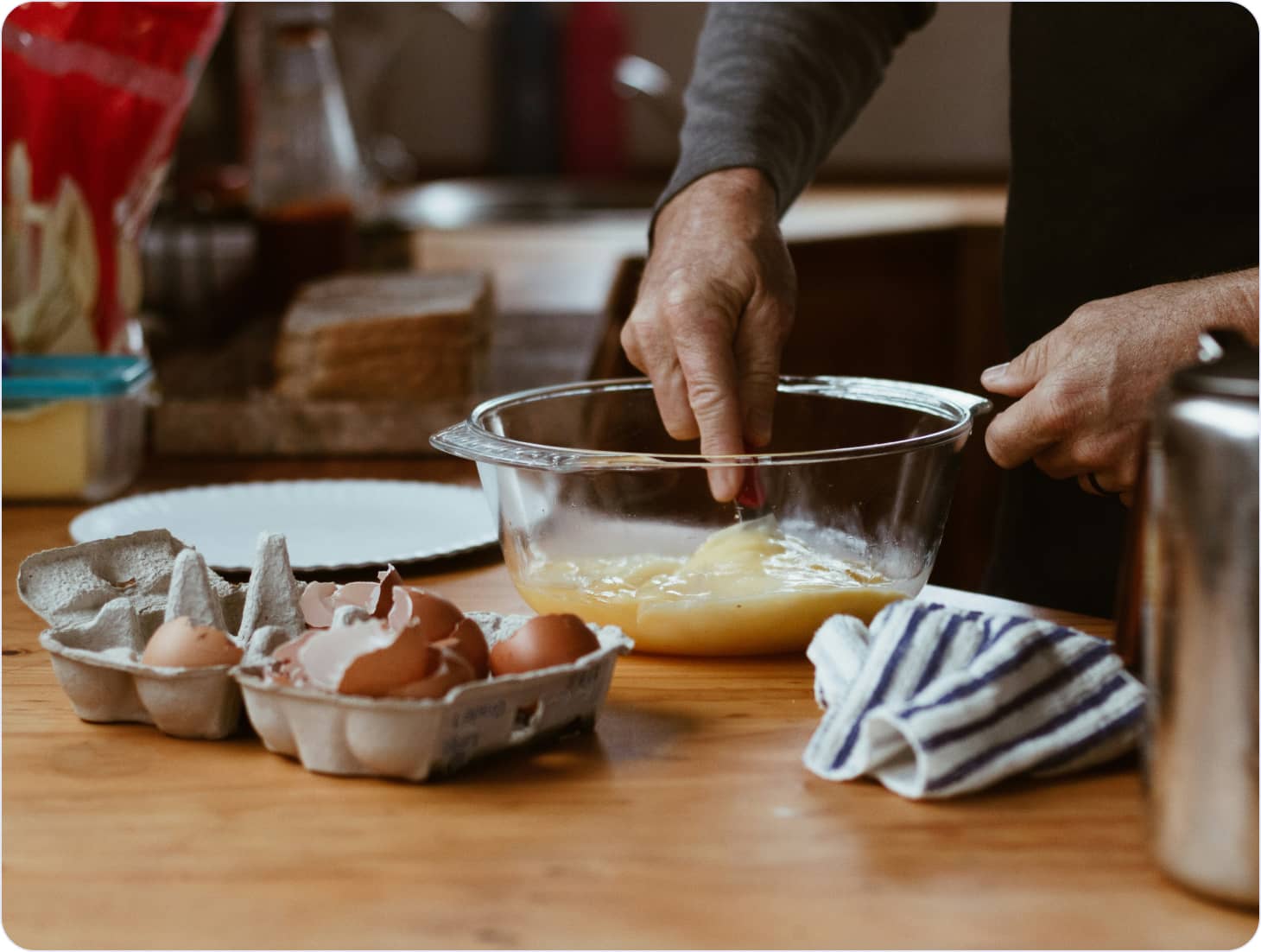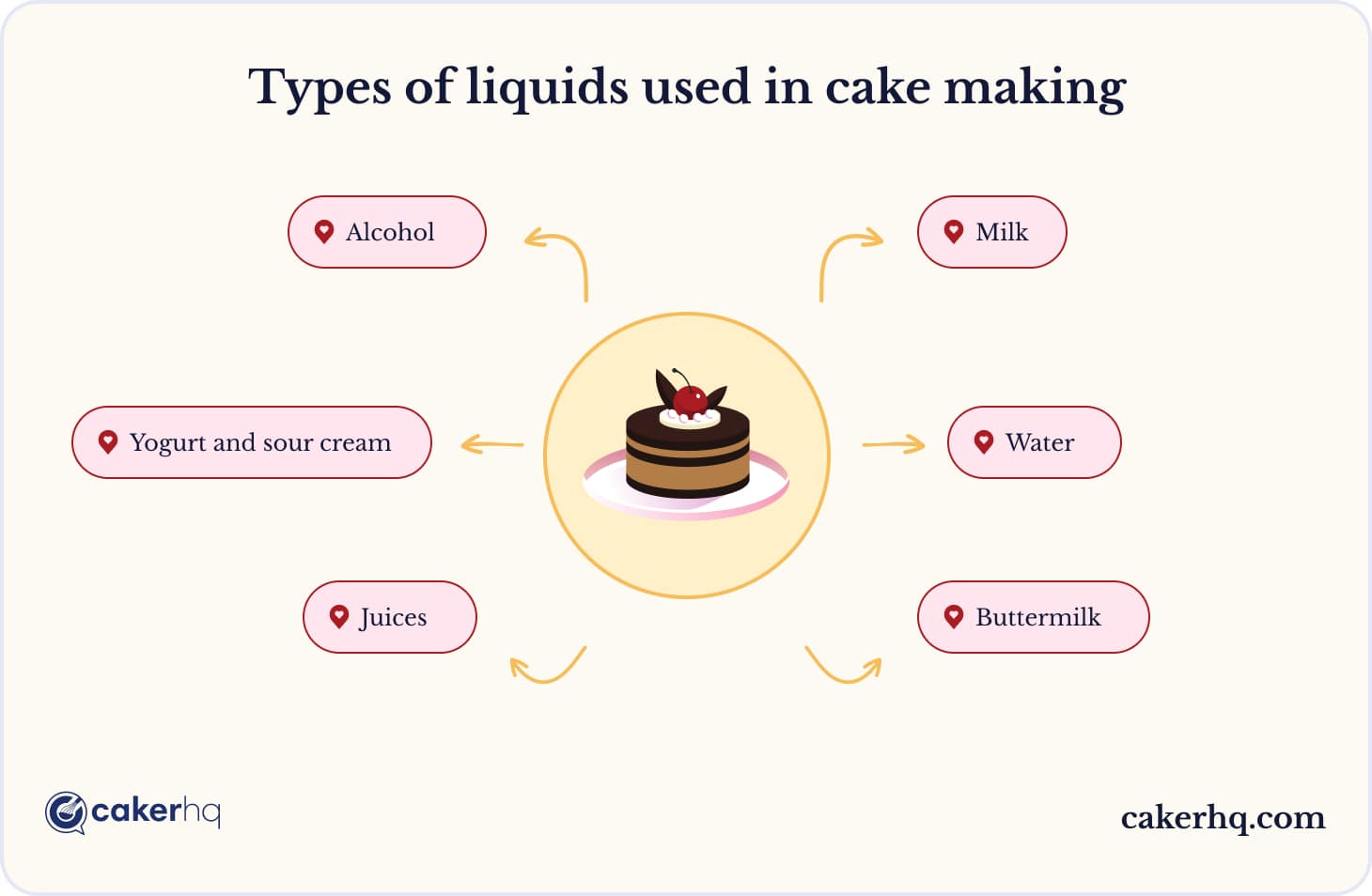When it comes to creating cakes and making them consistently good and healthy, the ingredients you use should be your primary concern. There are plenty of aspects to take into account when choosing cake ingredients. In this piece, we will look exactly at that. We’ll consider the most basic cake ingredients, as well as dive into more detail about each of them.
Key ingredients and their roles
In cake making, ingredients like flour, eggs, various liquids, and others form the backbone of cakes. Choosing them is not difficult, yet you still need to be mindful when choosing a particular product.
Flour
To give your cake structure and texture, flour is an irreplaceable ingredient in any cake. The type of flour directly affects the final product, changing its texture and taste. Let's explore the different types of flour, the role of gluten, and how substitutions can affect your cake.
Types of flour
- All-purpose flour. Commonly called Plain Flour, this is the most commonly used flour in baking. It has a moderate protein content (about 10-12%), making it versatile for various baked goods, including cakes. It is perfect for generally balancing the tenderness of the cake and its structure.
- Cake flour. With a lower protein content (about 7-8%), cake flour is finely milled and often bleached, which results in a softer, more tender cake with a fine crumb. It's ideal for light, fluffy cakes like angel food or chiffon cakes.
- Whole wheat flour. This flour contains the entire wheat kernel, giving it a higher fiber content and a denser texture. Cakes made with whole wheat flour are typically heavier and have a more pronounced wheat flavour. Besides, combining it with an all-purpose flour will help you avoid overly dense cakes.
- Self-rising flour. This is all-purpose flour with added baking powder and salt. It's convenient for recipes that require leavening but should be used with caution to avoid altering the balance of cake ingredients.
Substitutions and their effects
Apart from the regular flours mentioned, you can substitute them with various others! Yet, changing the type of flour in a cake recipe can alter its texture, flavour, and structure. Regardless, here are flours you should look into:
- Almond flour. Made from finely ground almonds, this flour is gluten-free and adds a rich, nutty flavour to cakes. It produces a denser, moister crumb and is often used in conjunction with other flours.
- Coconut flour. Also gluten-free, coconut flour absorbs more liquid than regular flour, requiring adjustments in the recipe. It adds a slight coconut flavour and creates a denser texture.
- Gluten-free flour blends. These blends are designed to mimic the properties of all-purpose flour without gluten. They can be a direct substitute, but results can vary based on the brand and blend composition.
- Oat flour. Made from ground oats, this flour adds a mild, slightly sweet flavour and can create a more crumbly texture. It can be used in combination with other flours to maintain the cake's structure.
- Spelt flour. An ancient grain with a lower gluten content than wheat flour, spelt flour can add a slightly nutty flavour and tender texture. It's often used in combination with all-purpose flour.
Another aspect worth considering is gluten and its presence in your bakes. It is crucial for providing structure and elasticity to baked goods. When you mix flour with water, gluten proteins prevent the air from leaving the dough, allowing the cake to rise and maintain its shape.
The amount of gluten development can significantly affect the texture of your cake. On the one hand, high gluten development results in a firmer, chewier texture. This is desirable in bread but not ideal for cakes. On the other hand, low gluten development results in a tender, crumbly texture, which is perfect for cakes.
Sugar
Just like flour, sugar is a key ingredient in baking, significantly influencing the sweetness, texture, moisture, and appearance of cakes. Different types of sugar can produce varied results, making it essential to understand what role each of them plays in the cake.
Types of sugar
- Granulated sugar. The most common type of sugar, granulated sugar, has a fine, crystalline texture. It's super common in a wide range of baking applications.
- Brown sugar. Brown sugar contains molasses, which gives it a moist texture and a rich, caramel-like flavour. Generally, it increases moisture and deepens the cake’s flavour, often resulting in a softer, more tender crumb.
- Powdered sugar (confectioners' sugar). This sugar is finely ground and mixed with a small amount of cornstarch to prevent clumping. It's commonly used in icings, frostings, and for dusting cakes. Besides, powdered sugar dissolves fast, while also helping make the the texture smoother.
- Raw sugar. Raw sugar, like turbinado or demerara, has larger crystals and a slight molasses flavour. It adds a subtle crunch and is often used as decoration on cakes.
- Liquid sugars (honey, maple syrup, corn syrup). These sugars add moisture and a unique flavour to cakes. They can also affect the cake's texture and browning. Adjustments to other liquids in the recipe may be needed when using liquid sugars.
Sugars, in whatever form they come, greatly affect the sweetness, texture, and moisture of your cakes.
Speaking of sweetness, it is sugar's primary role to add it and balance the flavours in a cake. Needless to mention that the type and amount of sugar used can impact the overall flavour profile of any treat you create.
When it comes to texture, sugar contributes to it by tenderising the crumb. It interferes with gluten formation, resulting in a softer, more tender cake. Sugar also helps to aerate the batter during creaming, creating a very fluffy texture.
Lastly, to cover moisture, it’s important to remember that sugar is hygroscopic, meaning it attracts and retains moisture. This helps keep cakes moist and extends their shelf life. Brown sugar, with its higher molasses content, is perfect for retaining moisture.
How sugar affects browning and caramelisation
Sugar is also an important factor in browning and caramelisation. For instance, through the Maillard reaction, sugar reacts with proteins at high temperatures, leading to browning. This enhances the flavour and creates a visually appealing golden-brown crust on the cake.
When sugar is heated to high temperatures, it melts and caramelises, developing complex flavours and a rich, amber colour. This process contributes to the depth of flavour in baked goods.
Remember that the type of sugar used can influence the extent and nature of browning and caramelisation. For example, brown sugar, with its molasses content, tends to brown more quickly and adds a deeper caramel flavour compared to granulated sugar.
Fats
In cake making, fats are no less important than any other ingredient. Different types of fats have unique properties, so knowing what each of them can do to your cakes is really important. Traditionally, let’s look at the types:
- Butter. It is THE most popular choice in baking. It adds a wonderful flavour and helps create a tender crumb with ease. It contains about 80% fat, where 20% are usually milk solids and water.
- Oil. Various types, like vegetable oil, canola oil, or olive oil, are 100% fat. They contribute to a moist and tender texture. Unlike butter, oils remain liquid at room temperature, resulting in cakes that stay softer for longer periods. They are known to be the most versatile due to their neutral or almost neutral flavour and smell.
- Shortening. It is a hydrogenated vegetable fat that is solid at room temperature. It is often used in recipes requiring stability and a tender crumb, such as frostings and some cake batters.
- Margarine. Essentially, it is a butter analog mainly made from vegetable oils and water. It can be used in place of butter, but the flavour and texture may differ slightly. It's essential to choose a margarine with a high-fat content for baking purposes.
- Lard. It is a rendered pork fat and was traditionally used in baking for its ability to create exceptionally flaky and tender textures. It's less commonly used today but can still be found in some traditional recipes.
In cake recipes, fats affect two important aspects, namely the cake’s tenderness, and taste. Speaking of the first, fats coat the flour's protein molecules, preventing them from forming strong gluten networks. This results in a tender, crumbly texture. Yet, the type and amount of fat used can have different effects on softness and crumb structure.
Regarding the taste, fats add richness to it. Butter, in particular, provides a distinct, creamy taste that is highly valued in baking. Oils can add subtle nuances, while margarine and shortening offer a more neutral taste profile.
Eggs
Another irreplaceable ingredient! Eggs are essential in almost every recipe, as they provide structure, moisture, and leavening to cakes. In cake making, two parts of egg is used: whites and yolk.
- Egg white (Albumen). The clear liquid surrounding the yolk consists mostly of water and proteins. This part is essential for structure and leavening.
- Egg yolk. It is rich in fats, proteins, vitamins, and minerals. Unlike whites, yolks add richness, colour, and flavour to cakes.
Just like we did with other ingredients, let’s see how eggs affect your cakes. In particular, they affect the structure, add moisture, and provide leavening.
Speaking of structure, eggs provide it by coagulating during baking. The proteins in both the whites and yolks set and create a firm network, helping the cake hold its shape. This is particularly important for cakes that need to rise and maintain a stable structure.
Secondly, eggs add moisture to the cake batter. The water content in eggs helps to hydrate the dry ingredients, resulting in a more tender and moist crumb.
Lastly, eggs contribute to leavening, especially when beaten. The process of beating eggs incorporates air, which expands during baking, helping the cake rise. Egg whites, when whipped, can create a foam that significantly increases the cake's volume.
Source: Unsplash
However, you may also wonder when to use whole eggs and when to use only whites/yolks. Each of them has effects on cakes. For instance:
- Whole eggs. They provide a balance of structure, moisture, richness, and leavening. They are the most commonly used form in cake recipes, ensuring a harmonious blend of all the desired properties.
- Egg whites. Egg whites are pure proteins and water. Therefore, they are ideal for creating structure and leavening. When whipped, they form a stable foam that can be folded into the batter to create light, airy cakes like angel food cake or chiffon cake. However, using only egg whites can result in a drier, less flavourful cake since they lack the fats found in yolks.
- Egg yolks. Egg yolks add richness, colour, and flavour to cakes due to their fat content. They also contribute to a tender crumb and can help emulsify the batter, leading to a smoother texture. Cakes that use only egg yolks, such as some pound cakes, tend to be richer and denser.
Looking to sell you professional treats? Do it with CakerHQ! Sign up now
Leavening agents
In cake making, leavening agents are irreplaceable if you need to give your bakes their rise and airy texture. Yet, as with any other ingredient, there are many types of leavening agents to choose from.
- Baking soda (sodium bicarbonate). Baking soda is a base that reacts with acidic ingredients (such as buttermilk, vinegar, or lemon juice) to produce carbon dioxide gas. This reaction occurs immediately upon mixing, creating bubbles that expand during baking to leaven the cake.
- Baking powder. Baking powder contains both an acid (usually cream of tartar) and a base (baking soda). Generally, it can come in two forms: single and double acting baking powder. The first one reacts once when mixed with wet ingredients, while the latter reacts in two stages. Once when mixed with wet ingredients and again when exposed to heat. Double-acting baking powder is the most commonly used type in baking.
- Yeast. It is a living organism that ferments sugars in the dough, producing carbon dioxide and alcohol. This process takes time and is used mainly in bread baking. However, yeast can be used in some types of cakes, such as stollen, where a denser, more bread-like texture is desired.
- Steam. While not a leavening agent per se, steam plays a crucial role in certain types of cakes, such as sponge cakes and choux pastry. The high moisture content in the batter turns to steam during baking, causing the cake to rise.
- Air. It is incorporated into cake batters through methods like creaming butter and sugar or whipping eggs. This trapped air expands during baking, contributing to the cake's rise and light texture.
The importance of proper usage and measurements
Using leavening agents correctly is crucial for achieving the desired texture and rise in your cakes.
To not spoil the cake, make sure you’re accurate with measurements. For example, too much leavening agent can cause the cake to rise too quickly, leading to a collapse or a coarse, irregular crumb. On the other hand, too little can result in a dense, heavy cake. Thus, measure precisely, following the recipe closely. Besides, even after using just the right amount, make sure to evenly distribute leavening agents throughout the batter.
Timing is another thing to consider. The chemical reaction of baking soda and single-acting baking powder starts as soon as they are mixed with wet ingredients. Therefore, it's essential to bake the batter promptly. Double-acting baking powder provides a bit more flexibility, but it's still best not to delay too long.
Lastly, do not forget about freshness, as leavening agents lose their potency over time. Always check expiration dates and store them in a cool, dry place. If you're unsure about the freshness of baking powder, you can test it by adding a teaspoon to a small amount of hot water. If it bubbles vigorously, it's still good.
Liquids
There are tons of types of liquids that can be added to cakes to achieve different effects. Basically, their role extends beyond merely adding moisture. So, let’s see what can be added to cakes and what effect they will have.
Types of liquids
- Milk. It is one of the most common and versatile liquids used in baking. It adds moisture, helps to dissolve sugar and salt, and provides fat and protein. It helps to make the crumb more tender and improve the flavour..
- Water. A neutral liquid that adds moisture without affecting the flavour. It’s often used when other ingredients for cake, like butter or oil, already provide sufficient fat and flavour.
- Buttermilk. It is slightly acidic and reacts with baking soda to produce carbon dioxide, aiding in leavening. It also tenderises the gluten, resulting in a softer crumb. Buttermilk adds a tangy flavour and is commonly used in recipes like red velvet cake and buttermilk pound cake.
- Juices. Fruit juices can add both moisture and flavour to cakes. For example, the most popular choices are orange, lemon, and apple juice, thanks to their distinctive taste. The acidity in some juices can also interact with leavening agents to improve the rise.
- Yogurt and sour cream. These dairy products add richness, moisture, and a slight tang. They contribute to a dense, moist crumb and are often used in pound cakes and coffee cakes.
- Alcohol. Spirits like rum, brandy, or liqueurs can add distinctive flavours to cakes. They also tenderise the crumb and contribute to moisture retention.
How liquids affect cake texture and crumb
As mentioned earlier, various liquids added to the cake have different effects. Moisture buildup is the most crucial effect of all. Hydrating the dry ingredients to make a cake is crucial for forming the batter. Besides, hydration ensures that the starches and proteins in the flour can interact correctly, leading to a cohesive structure.
Additionally, The amount and type of liquid affect gluten formation. More liquid generally means more gluten development, which can be beneficial for structure but must be balanced to avoid a tough crumb.
Lastly, different liquids activate leavening agents like baking powder and baking soda. They help to create the gas bubbles that make the cake rise. The type of liquid used can influence the extent and speed of this reaction.
The last but not least is taste. Liquids contribute to the flavour profile of the cake. Milk and buttermilk add richness and a slight tang, while juices and alcohol can introduce unique flavours. The choice of liquid can significantly affect the final taste of the cake.
Flavourings and additives
To transform basic ingredients into delightful and diverse cakes, flavourings and additives are the only and the best choice. Yet, there are tons of them, and each requires different usage. Some of the most common ones include:
Vanilla
There’s hardly a single person in the world that hasn,t tasted vanilla. It is one of the most popular flavourings in baking and is commonly used in all types of treats. It comes in various forms, including vanilla extract, vanilla bean paste, and whole vanilla beans. It adds a warm, sweet aroma and enhances other flavours in the cake.
Cocoa
Just like vanilla, cocoa powder is another extremely popular ingredient. It adds a rich, chocolate taste and can also affect the colour and texture of the cake. There are several types of cocoa, each having a different taste and texture.
Read also: The Difference Between Cacao and Cocoa: All You Need to Know
Spices
You can add many interesting spices to your cakes to alter the taste from “good” to “unique”. For example, cinnamon, nutmeg, ginger, and cloves add warmth and depth to cakes. They can be used individually or in combinations, such as in spice or pumpkin cakes.
Citrus zest
The grated outer peel of citrus fruits like lemons, oranges, and limes adds a bright, tangy flavour and aroma. Zest contains essential oils that provide intense flavour without adding extra moisture.
Extracts and oils
In addition to vanilla, other extracts like almond, lemon, and peppermint are used to impart specific flavours. Essential oils can also be used, but they are much more concentrated and should be used sparingly and in accordance with food safety regulations.
Liquors and liqueurs
Alcoholic beverages like rum, brandy, or flavoured liqueurs add complexity and depth to cakes. They also help in retaining moisture.
Herbs and flowers
Fresh or dried herbs (like rosemary or lavender) and edible flowers (like rose petals or hibiscus) can add unique flavours and visual appeal to cakes.
How different additives influence taste and appearance
Various additives contribute to both the visual appeal and taste of cakes. For instance, food colouring, both natural and artificial, is used to achieve specific colours in cakes. Natural colourants include beet juice, turmeric, and spirulina, while artificial colours offer a broader range of hues and more intense colours.
Different nuts, such as pecans, almonds, and others, are ideal for adding crunch to the cake. Even poppy and sesame seeds can also add texture and a subtle nutty taste.
Another thing you can freely add is fruits. Again, they can be different: fresh, dried, freeze-dried, candied, you name it. They not only beautifully decorate the cake, but also dramatically improve the taste.
Beyond the cocoa powder mentioned earlier, adding chunks of chocolate, chocolate chips, or melted chocolate can intensify the chocolate flavour and add texture. Additives like fruit preserves, nut butter, or caramel can be swirled into the batter or used as fillings to add bursts of flavour and create beautiful patterns.
The use of natural vs. artificial flavourings
When choosing additives and flavourings, there’s always a debate about whether to use natural or artificial ingredients. In the cake-making business, this is an important aspect your customers will definitely pay attention to. So, let’s consider both.
On the one hand, natural flavourings are made from sources like plants, fruits, and spices. Thanks to vanilla extract, citrus zest, spices, and other ingredients, they tend to have a more authentic and complex taste profile. Therefore, they’re often preferred for their purity and lack of synthetic chemicals. After all, pros include a more authentic taste and the absence of synthetic chemicals, whereas cons can include variability in taste intensity and higher cost.
On the other hand, artificial flavourings are chemically synthesised to mimic natural flavours. They can be more stable and consistent in flavour and are often used to achieve tastes that are difficult to extract from natural sources, such as bubblegum or cotton candy. Artificial flavourings are typically more concentrated and can be more cost-effective. In the end, pros include consistency, stability, and cost-effectiveness, whereas cons include potential health concerns and a less authentic taste.
On a side note, calculating cake costs can be intricate, yet there’s a way to do it efficiently and with little to no margin. On CakerHQ, you can freely use an intuitive cake cost calculator, which is designed to account for simple cake ingredients, along with their volumes and sizes. Plus, it also accounts for overheads, time, and other variables to help you estimate the most accurate cake pricing.
Bottom line
If you think about it, it’s wonderful how little ingredients are needed to create such a huge variety of treats people have made into recipes. To some extent, the key is not in the diversity of ingredients but in the techniques used to work with them. Therefore, learning what each of the core ingredients can do to your cake and how it can alter the taste, smell, and appeal is super important.
Yet, the secrets of cake making don’t end with the ingredients. There is much more to it that we’ve always been eager to share in our blog. Feel free to check it out if you’re looking for more ideas, tips, and guides on cake-making, as well as the business aspects behind it.



